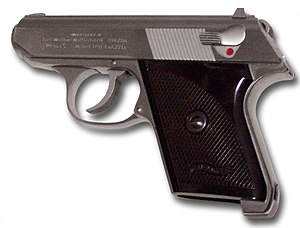Walther TPH
| Walther TPH | |
|---|---|

|
|
| general information | |
| Developer / Manufacturer: | Carl Walther GmbH, Zella-Mehlis / Ulm |
| Manufacturer country: | Germany, USA |
| Production time: | since 1968 |
| Weapon Category: | gun |
| Furnishing | |
| Overall length: | 135 mm |
| Total height: | 95 mm |
| Total width: | 23 mm |
| Weight: (unloaded) | 0.325 kg |
| Barrel length : | 71 mm |
| Technical specifications | |
| Caliber : |
.22 LR ; .25 ACP / 6.35mm |
| Possible magazine fillings : | 6 cartridges |
| Ammunition supply : | Bar magazine |
| Fire types: | THERE |
| Visor : | open sights |
| Closure : | Mass closure |
| Charging principle: | Recoil loader |
| Lists on the subject | |
The Walther TPH ( T ash P istole H ahn ) is a semi-automatic handgun of Carl Walther GmbH sporting guns . In July 1969, production of the new TPH model started parallel to the TPH model, which was being phased out. The TPH was also offered in the calibers 6.35 mm Browning and .22 lfb. Apart from the size, it looks very similar to the PPK and thus follows a successful and proven design.
description
It is a pistol with an unlocked spring mass lock, with the barrel, typically PPK, firmly connected to the frame and the recoil spring arranged around the barrel. Like the PPK, the TPH has a closed frame with an ejection window. The one-piece firing pin is held in position by the perforated safety roller and pierces it with the rear end. The roller is connected to the safety lever (60 ° safety) on the left side - a system that was patented on November 7, 1930 and used in the PP and PPK (cf. German Reich patent no. 578765). In the secured position, the trigger is decoupled from the release mechanism so that it can be pulled through in the secured position without any effect.
The TPH usually have a deep black, glossy surface that has a purple sheen on some weapons. Later models, especially the late .22 pistols, have a more matte gray finish. In addition to the standard models, a number of luxury versions and anniversary models were also offered. In addition, the US company Interarms started producing stainless versions for the US market in 1987. These models have slight differences in weight, the magazines, the locking spring and the sight marks. However, luxury designs and Interarms models will not be discussed here.
During its construction period, the TPH underwent only three changes in shape:
- 1970 (from SN 252 300): The trigger pawl and release lever were changed or, in older models, retrofitted using the "insert TPH 222 46 07" installation kit.
- 3/1986 (from SN 295 730): Change of the magazine holder with an additional pin
- TPH of late production: the trigger guard can only be swiveled down to dismantle the pistol if the magazine has been removed beforehand.
With the standard models, two different labeling variants are known on the left side of the slide. The models in caliber 6.35 mm Browning and models in caliber .22 lfb up to about the serial number 300,000 have a two-line label:
Carl Walther Waffenfabrik Ulm / Thu / Model TPH Cal. 22l.r. (6.35 mm)
Later models in caliber .22 lfb from serial number 300,000, however, have a simplified, single-line label:
TPH cal .22l.r.
The main difference between the TPH variants is the position of the serial number. On early models, the serial number can be found on the right-hand side of the handle behind the trigger. Then, between 1970 and 1971 around serial number 260,000, the position changed to the right side of the lock at the level of the muzzle. The late .22 models from around 300,000 onwards have the serial number below the ejection opening.
The TPH was produced until 1997 in a number of around 35,000 in caliber .22 lfb and around 20,000 in caliber 6.35 mm Browning. All weapons have a six-digit serial number above 250,000. Late .22 serial numbers hit just over 300,000. With around 55,000 weapons built, it can therefore be assumed that the weapons were numbered consecutively regardless of the caliber.
Walther bite
A major disadvantage of all small Walther handguns is the so-called "Walther Bite". Because of the short distance between the leading hand and the moving slide , long sequences of shots, for example at the shooting range, can lead to skin abrasions.
photos
literature
- Manfred Kersten, Wulf-H. Pflaumer, Franz Wonisch: Walther: a German legend . 1st edition. Weispfennig, Wuppertal 1997, ISBN 3-00-001356-3 .
Web links
Individual evidence
- ^ Stefan Klein: The Walther TPH. Stefan Klein, 2012, accessed on June 22, 2020 (English).


